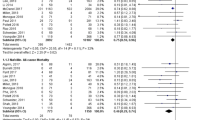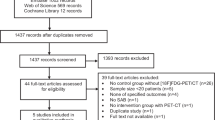Abstract
The aim of this letter was to point out some methodological concerns about an article written by Shi et al. and published in the journal. There is an increasing trend in the isolation of Methicillin-susceptible Staphylococcus aureus bacteremia and a variety of questions regarding the best therapy to treat this condition. These concerns might lead to selection, publication and information bias that prevent the generalization and application of these results in our clinical practice.
Similar content being viewed by others
Main text
Nowadays, there is an increasing trend in the isolation of Methicillin-susceptible Staphylococcus aureus (MSSA) bacteremia and plenty of questions regarding the best therapy to treat this kind of condition [1, 2]. According to this, we have carefully read the very recent article written by Shi et al. [3] which tries to respond the previous question, however we have found different flaws that prevent the generalization of these results.
The following are a few issues to be considered: 1. The search strategy is not presented in reproducible way, as it is described in Cochrane manual and other methodological strategies [4]. Besides, three elements are the most important to construct it: Population, Intervention and type of study [5]. On the contrary, the items shown were: Population, intervention, control and outcome, which might explain the limited number of articles found; 2. There are different strategies to saturate information in systematic reviews, however these were not shown here (P.e. Grey literature databases, clinical trial registries, thesis databases, google scholar, among others); 3.Regarding the Sensitivity analysis, authors explain that they excluded each publication, nonetheless they do not report the new results excluding the most weighted study (McDanel 2017; 81.5%) in the general analysis.
As we previously said, these important flaws, might lead to selection, publication and information bias that prevent the generalization and application of these results. Therefore, we might take them very carefully in our clinical practice.
Response to: “Interventions to treat Methicillin-susceptible Staphylococcus aureus bacteremia: Many methodological concerns”
Changcheng Shi and Fei Teng contributed equally to this work
We thank Garcia-Perdomo HA and Maldonado JFT for their interest in our work [3]. The responds to the comments are as following:
-
1.
We consider that the following three elements are required to ensure the repeatability of the search strategy: a) lists of databases, b) full search terms, and c) limitations on publication date. These three elements have been presented in our meta-analysis. Therefore, the search results of our meta-analysis are reproducible, to some extent. We agree that putting the full search strategies for each database into an Appendix may be better, as it is recommended by Cochrane Collaboration [4]. The full search strategies are described in Additional file 1: Tables S1-S3.
We agree that it is usually unnecessary to search on every aspect of the review’s clinical question (often referred to as PICO – that is Population, Intervention, Comparison and Outcome). In our meta-analysis, three elements (Population, Intervention and Comparison) were used as the search terms but not all the elements of PICO as Garcia-Perdomo HA and Maldonado JFT pointed out. Considering the Outcome may not be well described and are often not well indexed with controlled vocabulary terms, we did not use the search terms relating to Outcome. Types of study is important (typically a ‘filter’ for randomized trials) [4]. However, both randomized trials and observational studies met the criteria of our meta-analysis. Therefore, we did not use the terms relating to type of study.
-
2.
Regarding the database, it is recommended by Cochrane Collaboration that CENTRAL and MEDLINE should be searched, as a minimum, together with EMBASE if it is available to the review author [4]. CENTRAL is published as part of The Cochrane Library. PubMed provides access to a free version of MEDLINE that also includes up-to-date citations not have been indexed for MEDLINE yet. Therefore, we think our choice of database (PubMed, EMBASE and the Cochrane Library) is acceptable. We agree that searching more databases may be beneficial, but the other factors (e.g. time spending and budget considerations) need to be balance.
-
3.
We have performed a sensitivity analysis to evaluate the stability of our meta-analysis by excluding the study by McDanel et al. [6] and no inconsistency results were revealed (OR, 0.56; 95% CI, 0.37 to 0.84; I2 = 1.6%). In fact, the data have been shown in our publication (Additional file 1: Table S3) [3].
We agree that meta-analysis require a thorough, objective and reproducible search of a range of sources to identify as many relevant studies as possible to minimize bias.
Once again, thank Garcia-Perdomo HA and Maldonado JFT for their comments and suggestions.
Availability of data and materials
NA. There is no data available.
Abbreviations
- MSSA:
-
Methicillin-susceptible Staphylococcus aureus
References
Arias CA, Reyes J, Carvajal LP, Rincon S, Diaz L, Panesso D, et al. A prospective cohort multicenter study of molecular epidemiology and phylogenomics of Staphylococcus aureus bacteremia in nine Latin American countries. Antimicrob Agents Chemother. 2017;61:1–12.
Hultén K, Mason E, Lamberth L, Forbes A, Revell P, Kaplan S. Analysis of invasive community-acquired methicillin-susceptible Staphylococcus aureus infections during a period of declining community acquired methicillin-resistant Staphylococcus aureus infections at a large Children’s hospital. Pediatr Infect Dis J. 2018;37:235–41.
Shi C, Xiao Y, Zhang Q, Li Q, Wang F, Wu J, et al. Efficacy and safety of cefazolin versus antistaphylococcal penicillins for the treatment of methicillin-susceptible Staphylococcus aureus bacteremia : a systematic review and meta-analysis. BMC Infect Dis. 2018;18:508.
Higgins J, Green S. Cochrane Handbook for Systematic Reviews of Interventions Version 5.1.0; 2011.
García-Perdomo HA. Evidence synthesis and meta-analysis: a practical approach. Int J Urol Nurs. 2016;10:30–6.
McDanel JS, Roghmann MC, Perencevich EN, Ohl ME, Goto M, Livorsi DJ, et al. Comparative effectiveness of cefazolin versus nafcillin or oxacillin for treatment of methicillin-susceptible Staphylococcus aureus infections complicated by bacteremia: a nationwide cohort study. Clin Infect Dis. 2017;65:100–6.
Acknowledgements
None.
Funding
There was no funding.
Author information
Authors and Affiliations
Contributions
HG and JT analyzed and interpreted the information regarding the manuscript and wrote the article. All authors read and approved the final manuscript.
Corresponding author
Ethics declarations
Ethics approval and consent to participate
NA. This is a letter/correspondence based on the discussion of an article.
Consent for publication
NA. This is a letter/correspondence based on the discussion of an article.
Competing interests
The authors declare that they have no competing interests.
Additional information
Publisher’s Note
Springer Nature remains neutral with regard to jurisdictional claims in published maps and institutional affiliations.
Supplementary information
Additional file 1: Table S1.
Search strategy used in PubMed database. Table S2. Search strategy used in EMBASE database. Table S3. Search strategy used in the Cochrane Library database.
Rights and permissions
Open Access This article is distributed under the terms of the Creative Commons Attribution 4.0 International License (http://creativecommons.org/licenses/by/4.0/), which permits unrestricted use, distribution, and reproduction in any medium, provided you give appropriate credit to the original author(s) and the source, provide a link to the Creative Commons license, and indicate if changes were made. The Creative Commons Public Domain Dedication waiver (http://creativecommons.org/publicdomain/zero/1.0/) applies to the data made available in this article, unless otherwise stated.
About this article
Cite this article
García-Perdomo, H.A., Toro Maldonado, J.F. Interventions to treat methicillin-susceptible Staphylococcus aureus bacteremia: many methodological concerns. BMC Infect Dis 19, 892 (2019). https://doi.org/10.1186/s12879-019-4520-3
Received:
Accepted:
Published:
DOI: https://doi.org/10.1186/s12879-019-4520-3




